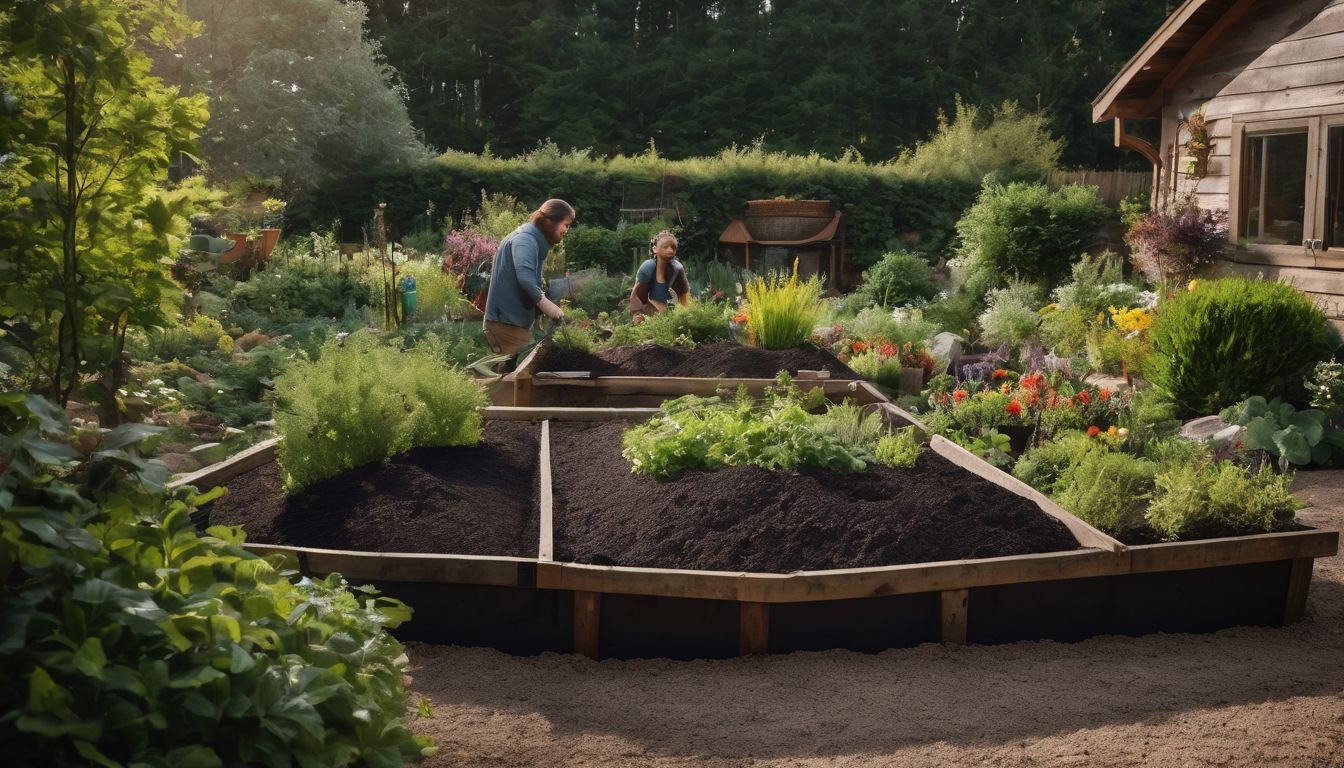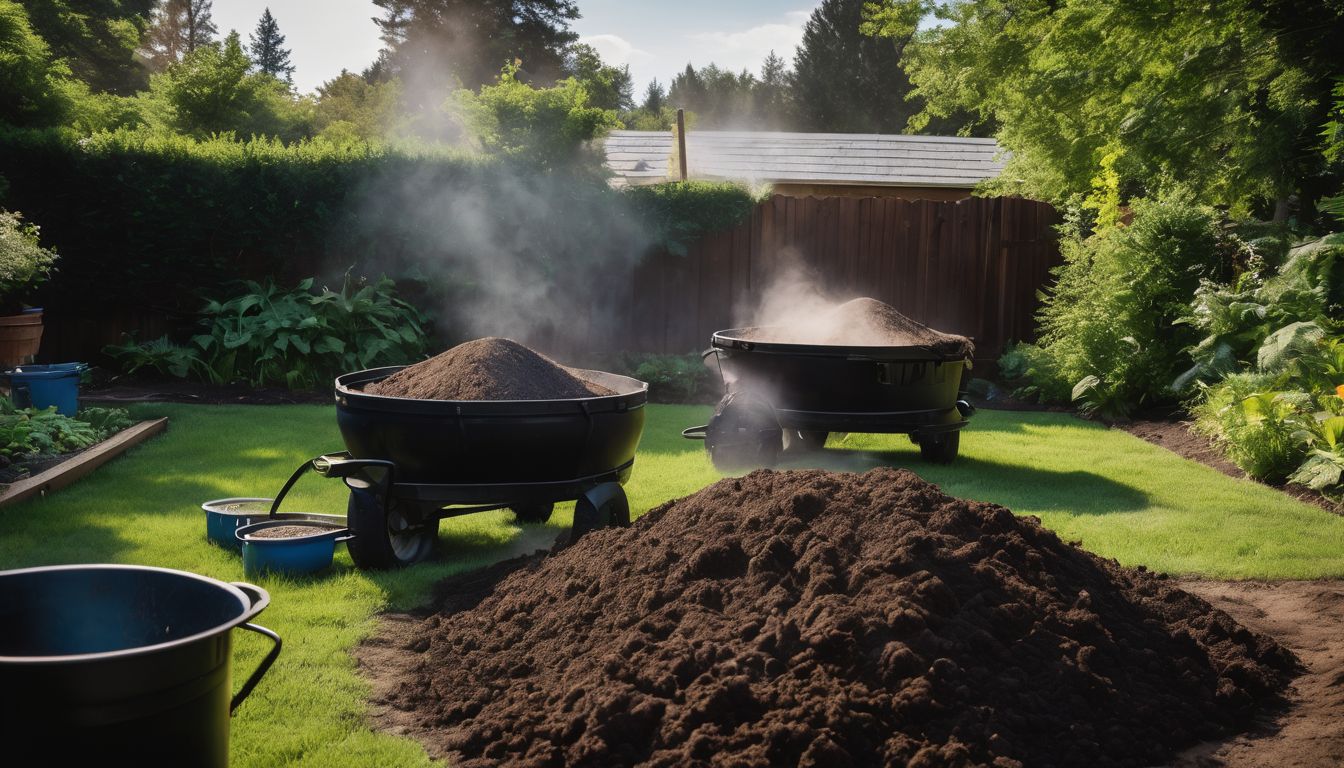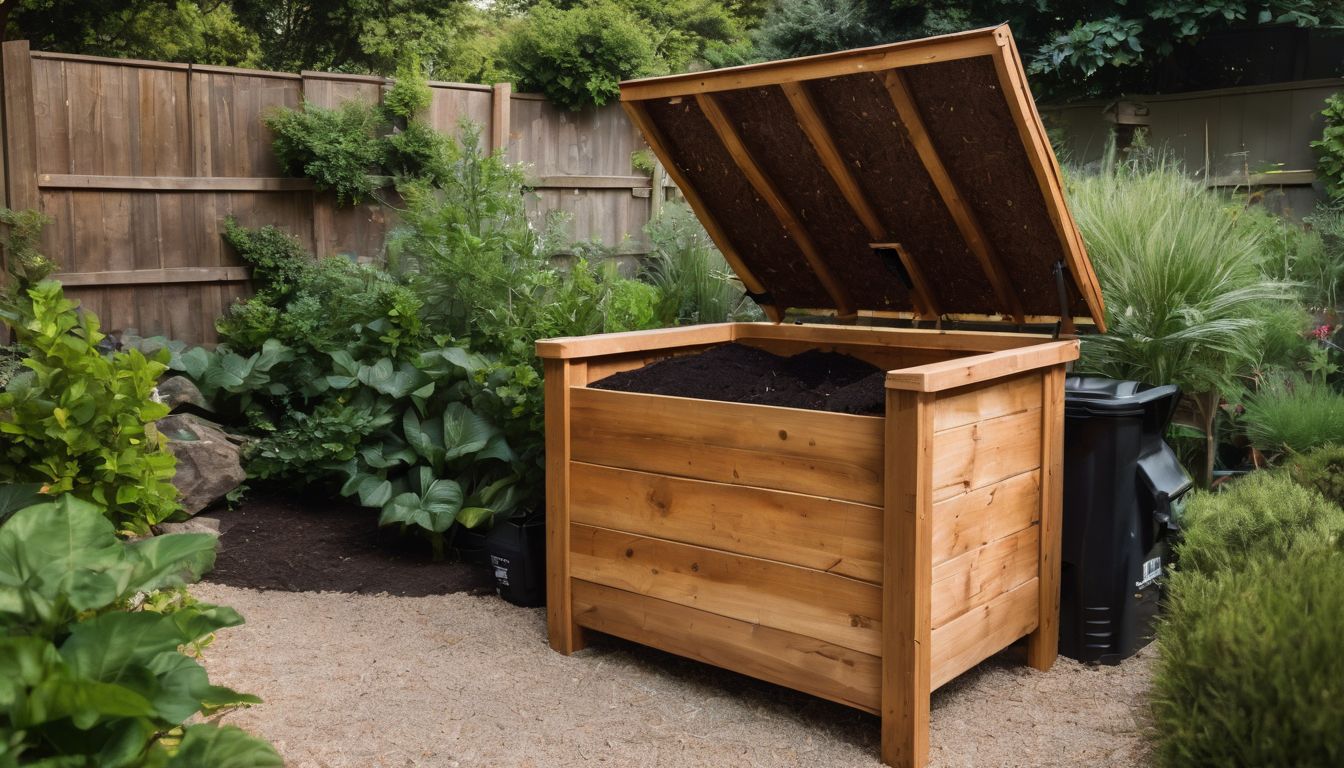Are you tired of seeing your kitchen scraps go to waste? Around 30% of what we throw away could be composted instead. This article will guide you through the simple steps to turn that waste into garden gold, nurturing plants and reducing landfill.
Let’s make soil, not trash!
Key Takeaways
- Composting at home reduces waste in landfills and curbs methane emissions, contributing to environmental conservation.
- Proper composting enriches the soil with nutrients, improves its structure, and lessens the need for chemical fertilisers, saving money in the process.
- Starting a compost pile requires green materials like vegetable peels and brown materials such as dry leaves; maintaining the right balance between them is key for success.
- Regular monitoring and turning of your compost pile ensure efficient breakdown of organic matter and prevention of odours or pests.
- Using finished compost in gardening routines enhances plant health, encourages strong root systems, and contributes to more sustainable growing practices.
Benefits of Composting
Composting has numerous benefits, including reducing waste, improving soil quality, and saving money on fertilisers. By composting organic waste, you can contribute to sustainable living and environmental conservation.
Reduces waste
Composting turns your kitchen scraps and yard waste into valuable soil amendment. Every peel, core, or leaf you add to the compost pile means less material heading to the landfill.
This simple step makes a big impact on waste management efforts. Organic matter in landfills releases methane, a potent greenhouse gas, but through aerobic decomposition at home, these organic materials break down harmlessly.
Embracing this eco-friendly practice helps reduce your environmental footprint. Microorganisms work tirelessly in your compost pile, transforming green waste and brown waste into nutrient-rich humus over time—like magic for your garden! Before we dig into how this enriches the soil quality of your garden, let’s consider what you’ll need to embark on successful composting at home.
Improves soil quality
Composting improves soil quality by adding essential nutrients and beneficial microorganisms to the earth. Nutrient-rich compost enhances soil structure, promoting better water retention and aeration for healthier plant growth.
The decomposition process in compost also helps to suppress diseases and pests while reducing the need for chemical fertilisers, making it a sustainable and eco-friendly practice that supports conservation efforts.
Furthermore, incorporating compost into your gardening routine enriches the soil with organic matter, improving its fertility and overall health. This encourages stronger root systems in plants, leading to more bountiful harvests and a thriving garden or yard.
Saves money on fertilisers
Improving soil quality through composting not only benefits your garden but also saves you money on fertilisers. Compost provides a natural and nutrient-rich alternative to store-bought fertilisers, reducing the need for expensive synthetic products.
By recycling kitchen scraps and yard waste into compost, you can create a cost-effective solution that enriches your soil while minimising the financial impact of maintaining a healthy garden.
Harnessing the power of composting to improve soil health is an eco-friendly practice that reduces reliance on chemical fertilisers. This approach ensures nutrient-rich soil without having to spend excessively on store-bought alternatives, aligning with environmentally conscious efforts towards sustainable gardening practices.
What You Need to Get Started
Before you start composting, it’s important to research the different composting options available. You’ll also need to choose or make a compost bin and gather green and brown materials for your pile.
Researching compost options
When researching compost options, consider the available space for your composting setup. Look into traditional bins or tumblers and evaluate their pros and cons. Think about the materials you have on hand and how much time you can commit to maintaining your compost.
Consider different compost systems like vermicomposting or bokashi if space is limited.
Explore the types of organic waste that are generated in your household to determine the appropriate composting method. Investigate local regulations and guidelines regarding composting practices to ensure compliance with any restrictions on certain materials or methods.
Choosing or making a compost bin
When choosing or making a compost bin, consider the size and location. Ensure it’s large enough to hold your composting materials but not so big that it overwhelms your space. Place the bin in a convenient spot with good air circulation and sunlight.
Alternatively, you can make a DIY compost bin using materials like wood pallets or wire mesh to create an open structure for easy access.
Consider the type of composting system that suits your needs best; options include tumblers, stackable bins, and enclosed containers. Each has its advantages, so research which one aligns with your lifestyle and available space.
Gathering green and brown materials
To get started with composting, you will need to gather green and brown materials. This process provides the necessary components for a successful compost pile. Here are the materials you will need:
- Green Materials: These include kitchen scraps like fruit and vegetable peels, coffee grounds, grass clippings, and plant trimmings.
- Brown Materials: These consist of dry leaves, straw, shredded paper or cardboard, and wood shavings.
Dos and Don’ts of Composting
When composting, do use green and brown materials like fruit and vegetable scraps, grass clippings, leaves, and eggshells. Don’t compost meat or dairy products as they can attract pests and create unpleasant odors.
For more tips on successful composting, keep reading!
What to compost
To create nutrient-rich soil, compost biodegradable materials like fruit and veggie scraps, coffee grounds, and eggshells. Then add yard waste such as grass clippings, leaves, and small branches. Ensure to avoid dairy products, meat, and pet waste in your compost. You should also steer clear of diseased plants or weeds with seeds. Finally, avoid adding any synthetic materials or non-biodegradable items to your compost pile.
What not to compost
To maintain a thriving compost pile, it’s essential to be mindful of the materials you should avoid adding. Here’s a detailed list of what not to compost:
- Meat and dairy products, as these can attract pests and create unpleasant odors.
- Oily or greasy foods, as they can hinder the decomposition process.
- Diseased plants or weeds with mature seeds that could spread in the compost.
- Pet waste, including cat and dog feces, due to potential harmful pathogens.
- Synthetic chemicals or treated wood products that may contaminate the compost.
Materials to use cautiously
When composting, use caution with materials such as meat and dairy products, which can attract pests and slow down the decomposition process. Also, avoid adding diseased plants or weeds with mature seeds to prevent spreading diseases and weed growth in your garden.
Now that you’re aware of the materials to use cautiously in composting, let’s move on to maintaining your compost pile for optimal results.
Maintaining Your Compost
After setting up your compost pile, it’s important to regularly monitor and turn the pile to ensure proper decomposition. This will help maintain the right balance of green and brown materials for successful composting.
Monitoring and turning the pile
Regularly monitor the compost pile to ensure that it stays moist but not waterlogged. Turning the pile every few weeks will help aerate the materials, speeding up decomposition. This process also helps distribute heat and moisture evenly, promoting a more efficient breakdown of organic matter.
Keep an eye on the temperature, aiming for at least 130-150°F (54-65°C) to kill off weed seeds and harmful pathogens while enhancing nutrient release. Use a compost thermometer for accurate readings and adjust the pile’s composition if necessary.
Tips and tricks for successful composting
To ensure successful composting, keep a good balance of green and brown materials. Regularly turning the pile will help aerate it, allowing for efficient decomposition. Keep your compost pile moist but not soggy – this encourages microbial activity.
Chopping up large items before adding them to the pile can speed up the process as well. Adding some finished compost or soil to your new pile provides beneficial microorganisms which aid in breaking down materials.
Another useful tip is to avoid compacting the compost down too much when turning it over; this can limit airflow and slow down decomposition. Additionally, being mindful of what you put into your compost is essential.
Using Compost in Your Garden or Yard
Once you have successfully produced nutrient-rich compost, it’s time to reap the rewards in your garden or yard. Compost can be used to improve soil health and fertility, leading to healthier plants and a more sustainable gardening routine.
How compost improves soil health
Compost improves soil health by adding essential nutrients and organic matter. This enriches the soil, helping plants grow stronger and healthier. Nutrient-rich soil enhances the availability of vital minerals needed for plant growth, resulting in better yields and more robust, disease-resistant plants.
Using compost also promotes a healthier ecosystem in the soil by increasing microbial activity and improving its structure. This enables better water retention and drainage, reducing erosion and nutrient leaching.
As a result, your garden or yard becomes more resilient to extreme weather conditions, ensuring sustainable gardening practices that benefit both the environment and your plants.
Ways to incorporate compost into your gardening routine
To incorporate compost into your gardening routine:
- Mix compost with potting soil for potted plants to improve water retention and nutrient availability.
- Spread a layer of compost around the base of trees and shrubs to promote healthy root development.
- Use compost as mulch in flower beds and vegetable gardens to suppress weed growth and retain moisture.
- Blend compost with existing soil when planting new flower beds or vegetable patches to enrich soil fertility.
- Create a compost tea by steeping compost in water, then use it as a natural fertiliser for your plants.
- Top – dress lawns with a thin layer of compost to enhance soil structure and encourage microbial activity.
Additional resources for composting information
Explore online platforms such as government websites, environmental organisations, and gardening forums for valuable composting resources. Join community workshops or attend local events to learn from experienced gardeners and experts in composting.
Books and magazines on sustainable living often provide in-depth information about composting techniques, troubleshooting common issues, and innovative ways to use compost in different areas of your home or garden.
Consider reaching out to local agricultural extension offices or universities for access to research articles, webinars, or training programs focused on composting. Engage with social media groups dedicated to sustainable practices where members share their experiences, tips, and advice on successful composting methods.
Conclusion
In conclusion, composting offers numerous benefits for both the environment and your garden. With the right knowledge and tools, anyone can start composting at home. By following these basic guidelines, you can create nutrient-rich soil while reducing waste.
Start your composting journey today and reap the rewards of healthier plants and a cleaner planet.
FAQs
1. What is composting and why is it important for beginners to learn?
Composting is a process that turns organic waste into nutrient-rich soil, which is great for garden soil enrichment and eco-friendly practices.
2. How does compost help the environment?
By turning kitchen and garden scraps into compost, you create ecofriendly, nutrient-rich soil that reduces landfill waste and enriches the earth’s ground.
3. Can I start composting if I live in an urban area with little space?
Yes! Even in small spaces, beginners can use bins or compact methods to produce their own ecofriendly, nutrient-rich soil through composting.
4. What materials should I start with when creating my first compost pile?
Focus on using everyday kitchen scraps like vegetable peels along with yard waste such as leaves to build your beginner’s base for rich soil through composting.





